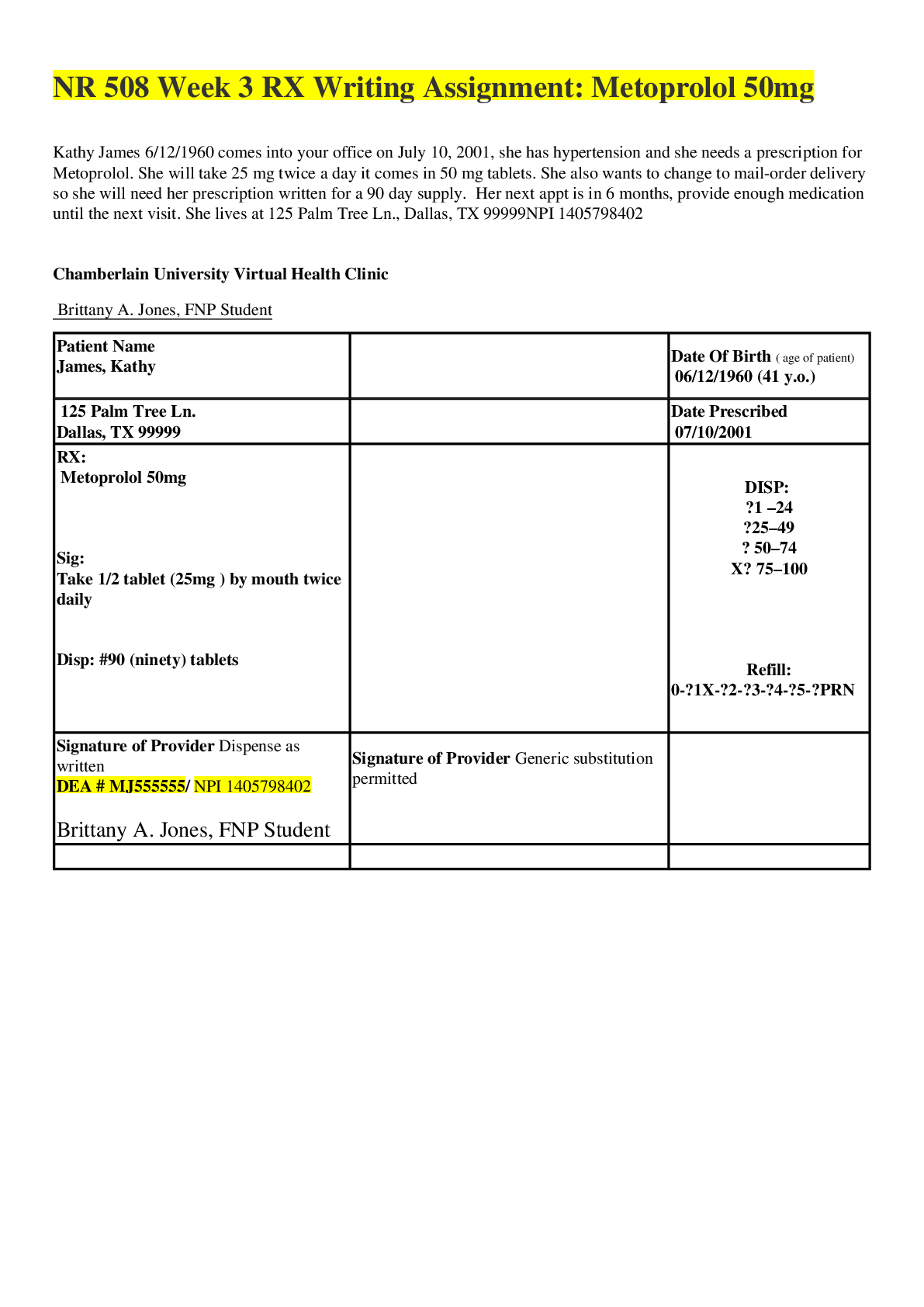Summary Chapter 3 Biology and Behavior
Document Content and Description Below
Detailed summary of Chapter 3: Biology and Behavior, in Michael Gazzaniga's 'Pscyhological Science' fifth edition.
Chapter 3 - Biology and Behavior
I. 3.1 How Does the Nervous System Operate
A.
...
The nervous system is responsible for everything people think, feel, or do. 1.
a) The basic units of the nervous system; cells that receive, integrate, and transmit information in the nervous system. They operate through electrical impulses, communicate with other neurons through chemical signals, and form neural networks.
B. The Nervous System Has Two Basic Divisions
1. Neural networks are linked, and together they form the nervous system. The entire nervous system is divided into two basic units:
a)
(1) The brain and the spinal cord.
b) Peripheral nervous system (PNS)
(1) All nerve cells in the body that are not part of the central nervous system. The peripheral nervous system includes the somatic and autonomic nervous systems.
2.
C. Neurons Are Specialized for Communication
1. Neurons are specialized for communication. That is, unlike other cells in the body, nerve cells are excitable:
a) Powered by electrical impulses and communicate with other neurons through
chemical signals
b) Reception phrase
(1) Neurons take in the chemical signals from neighboring neurons.
c) Integration phrase
(1) incoming signals are assessed.
d) Transmission phrase
(1) they pass their own signals to yet other receiving neurons.
2. TYPES OF NEURONS
a) Sensory neurons
(1) One of the three types of neurons; these neurons detect information from the physical world and pass that information to the brain (usually through the spinal cord).
(2) somatosensory nerves
(a) provide information from the skin and muscles
b) Motor neurons
(1) One of the three types of neurons; these neurons direct muscles to contract or relax, thereby producing movement
c) Interneurons
(1) One of the three types of neurons; these neurons communicate within local or short-distance circuits.
d) Reflexes
(1) automatic motor responses, occur before we even think about those responses.
3. NEURON STRUCTURE
a) typical neuron has four structural regions that participate in communication functions:
(1) Dendrites
(a) Branch Like extensions of the neuron that detect information from other neurons.
(2) Cell body (or Soma)
(a) The site in the neuron where information from thousands of other neurons is collected and integrated.
(3) Axon
(a) A long narrow outgrowth of a neuron by which information is transmitted to other neurons.
(4) Terminal button
(a) At the ends of axons, small nodules that release chemical signals from the neuron into the synapse.
b) Synapse
(1) The gap between the axon of a “sending” neuron and the dendrites of a “receiving” neuron; the site at which chemical communication occurs between neurons.
c) Membrane
(1) Covers the neuron
(2) a fatty barrier that does not dissolve in the watery environment inside and outside the neuron. The membrane is semipermeable. In other words, some substances move in or out of the membrane,
(3) Ion channels
(a) These specialized pores allow ions to pass in and out of the cell when the neuron transmits signals down the axon.
(b) ions
(i) molecules, some charged negatively and some charged positively.
d) Plays an important role in communication between neurons: It regulates the concentration of electrically charged molecules that are the basis of the neuron’s electrical activity.
4.
D. The Resting Membrane Potential Is Negatively Charged
1. When a neuron is resting, not active, the electric charge inside and outside the membrane is different.
a) Resting membrane potential
(1) The electrical charge of a neuron when it is not active.
(2) the ratio of negative to positive ions is greater inside the neuron than outside it. Therefore, the electrical charge inside the neuron is slightly more negative than the electrical charge outside—typically –70 millivolts (about 1/20 the charge of a AA battery).
(3) Polarized
(a) When a neuron has more negative ions inside than outside
(b) The polarized state of the resting neuron creates the electrical energy necessary to power the firing of the neuron.
2. THE ROLES OF SODIUM AND POTASSIUM IONS
a) Two types of ions that contribute to a neuron’s resting membrane potential;
(1) Sodium ions
(a) Can only pass through sodium channels
(2) Potassium ion
(a) Can only pass through potassium channels
b) Because of permeability more potassium ion pass through than sodium ions
c) Sodium-potassium pump
(1) This pump increases potassium and decreases sodium inside the neuron, activity that helps maintain the resting membrane potential.
E. Action Potentials Cause Neural Communication
1. Neural communication depends on a neuron’s ability to respond to incoming stimulation.
a) The neuron responds by changing electrically and then passing along signals to other neurons
b) Action potential (or neural firing)
(1) The electrical signal that passes along the axon and subsequently causes the release of chemicals from the terminal buttons.
2. CHANGES IN ELECTRICAL POTENTIAL LEAD TO ACTION
a) The signals arrive at the dendrites by the thousands and are of two types:
(1) Excitatory Signals
(a) depolarize the cell membrane (i.e., decrease polarization by decreasing the negative charge inside the cell).
(b) Through depolarization, these signals increase the likelihood that the neuron will fire.
(2) Inhibitory signals
(a) hyperpolarize the cell (i.e., increase polarization by increasing the negative charge inside the cell).
(b) Through hyperpolarization, these signals decrease the likelihood that the neuron will fire.
b) If the total amount of excitatory input surpasses the neuron’s firing threshold (– 55 millivolts), an action potential is generated.
c) Neuron fires sodium gates open
(1) Allows more sodium ions to enter
(a) Creates a more positive charge inside
(i) A fraction of a second later, potassium channels open to let potassium ions rush outside the cell membrane
(ii) Sodium and potassium channels close so sodium ions
stop entering and potassium ions stop exiting the cell membrane
(a) Thus, electrical charge inside the cell
becomes slightly negative initial resting state
(i) As the cell fires and allows more
positive ions inside, the charge becomes positive.
(ii) Through natural restoration,
including the activity of the sodium-potassium pump, the charge then returns to its slightly negative resting state
3.
4. ACTION POTENTIALS SPREAD ALONG THE AXON
a) When the neuron fires, the cell membrane depolarization moves along the axon like a wave.
b) Myelin Sheath
(1) A fatty material, made up of glial cells, that insulates some axons to allow for faster movement of electrical impulses along the axon.
(2) Nodes of Ranvier
(a) Small gaps of exposed axon, between the segments of myelin sheath, where action potentials take place.
(3) It pauses briefly to be recharged at each node along the axon. The entire process takes about 1/1,000 of a second, permitting the fast and frequent adjustments required for coordinating motor activity.
5. ALL-OR-NON PRINCIPAL
a) ALL-OR-NONE principal
(1) The principle that when a neuron fires, it fires with the same potency each time; a neuron either fires or not—it cannot partially fire, although the frequency of firing can vary.
F. Neurotransmitters Bind to Receptors Across the Synapse
1. Presynaptic neuron
a) The neuron that sends the signal
2. Postsynaptic neuron
a) The one that receives the signal
3.
a) Neurotransmitters
(1) Chemical substances that transmit signals from one neuron to another.
b) Receptors
(1) In neurons, specialized protein molecules on the postsynaptic membrane; neurotransmitters bind to these molecules after passing across the synapse.
4. NEUROTRANSMITTERS BIND WITH SPECIFIC RECEPTORS
a) More than 60 chemicals convey information in the nervous system.
b) Different neurotransmitters influence emotion, thought, or behavior.
c) The three major events that terminate the neurotransmitter’s influence in the synapse:
(1) Reuptake
(a) The process whereby a neurotransmitter is taken back into the presynaptic terminal buttons, thereby stopping its activity.
(2) Enzyme deactivation
(a) occurs when an enzyme destroys the neurotransmitter in the synapse. Different enzymes break down di erent neurotransmitters.
(3) Autoreceptors
(a) monitor how much neurotransmitter has been released into the synapse. When an excess is detected, the autoreceptors signal the presynaptic neuron to stop releasing the neurotransmitter.
G. Neurotransmitters Influence Mental activity and Behavior
1. Agonists
a) Drugs and toxins that enhance the actions of neurotransmitters
2. Antagonist
a) Drugs and toxins that inhibit these actions
3. Drugs and toxins can also mimic neurotransmitters and bind with their receptors as if they were the real thing
a) EX). Heroin is addictive because it's chemically similar to naturally occurring
neurotransmitters. Receptor cannot differentiate from artificial to natural
4. TYPES OF NEUROTRANSMITTERS
a) Epinephrine/ adrenaline
(1) A monoamine neurotransmitter responsible for bursts of energy after an event that is exciting or threatening.
b) Norepinephrine
(1) A monoamine neurotransmitter involved in states of arousal and attention.
c) Serotonin
(1) A monoamine neurotransmitter important for a wide range of psychological activity, including emotional states, impulse control, and dreaming.
d) Dopamine
(1) A monoamine neurotransmitter involved in motivation, reward, and motor control over voluntary movement.
e) GABA
(1) Gamma-aminobutyric acid; the primary inhibitory transmitter in the nervous system.
f) Glutamate
(1) The primary excitatory transmitter in the nervous system.
g) Endorphins
(1) Neurotransmitters involved in natural pain reduction and reward. (2)
II. What Are the Basic Brain Structures and Their Functions
A. The brain is best viewed as a collection of interacting neural circuits.
B. These circuits have accumulated and developed throughout human evolution.
C. EARLY RESEARCHERS DEBATED THE RELATIONSHIP BETWEEN STRUCTURES AND FUNCTION
1. Franz Gall and Johann Spurzheim
a) proposed that if a person used a particular mental function more than other mental functions, the part of the brain where the emphasized function was performed would grow
b) Phrenology
(1) By carefully feeling the skull, one could describe the personality of the individual.
(2) It was pseudoscience he saw correlations but not on to the scientific
method—however it showed that brain functions are localized
2. Paul Broca
a) Broca’s area
(1) A small portion of the left frontal region of the brain, crucial for the production of language.
D. Scientist Can Now Watch the Working Brain
1. Psychophysiological assessment
a) In this type of testing, researchers examine how bodily functions (physiology) change in association with behaviors or mental states (psychology).
b) EX). polygraph
2. ELECTROPHYSIOLOGY
a) Electrophysiology
(1) a data collection method that measures electrical activity in the brain.
(2) electroencephalograph (EEG)
(a) A device that measures electrical activity in the brain.
(b) the EEG is limited. Because the recordings (electroencephalograms) reflect all brain activity, they are too “noisy” or imprecise to isolate specific responses to particular stimuli
(3) Event-related potential (ERP)
(a) A more powerful way of examining how brain activity changes in response to a specific stimulus involves conducting many trials with a single individual and averaging across the trials.
3. BRAIN IMAGING
a) Brain Imaging
(1) measure changes in the rate, or speed, of the flow of blood to di erent regions of the brain.
(2) Positron emission tomography
(a) A method of brain imaging that assesses metabolic activity by using a radioactive substance injected into the bloodstream.
(3) Magnetic resonance imaging (MRI)
(a) A method of brain imaging that uses a powerful magnetic field to produce high-quality images of the brain.
(4) Functional magnetic resonance imaging (fMRI)
(a) An imaging technique used to examine changes in the activity of the working human brain by measuring changes in the blood’s oxygen levels.
4. TRANSCRANIAL MAGNETIC STIMULATION
a) One limitation of brain imaging is that the findings are necessarily correlational.
b) Transcranial magnetic stimulation (TMS)
(1) The use of strong magnets to briefly interrupt normal brain activity as a way to study brain regions.
E. The Brainstem Houses the Basic Programs of Survival
1. The spinal cord is a rope of neural tissue.
a) The cord runs inside the hollows of the vertebrae from just above the pelvis up into the base of the skull.
b) Functions is reflec
c) The spinal cord is seen to be composed of two distinct tissue types :
(1) Gray matter—neurons cell’ bodies
(2) White matter—axons and fatty myelin sheaths
2. Brain stem
a) An extension of the spinal cord;it houses structures that control functions associated with survival, such as heart rate, breathing, swallowing, vomiting, urination, and orgasm.
b) Consists of Medulla oblongata, pons, midbrain
c) Significant blow to this region can cause death
d) The brain stem also contains a network of neurons, known collectively as the
reticular formation
(1) Projects up to the cerebral cortex—(outer portion of the brain— discussed shortly) and a ects general alertness.
F. The Cerebellum Is Essential for Moment
1. Cerebellum
a) A large, convoluted protuberance at the back of the brain stem; it is essential for coordinated movement and balance.
2. ›
G. Subcortical Structures Control Emotions and Appetitive Behaviors
1. Forebrain
a) Above the brainstem and cerebellum
b) Consists of left and right cerebral hemispheres
c) Subcortical regions
(1) Lie under the cortex
2. Thalamus
a) The gateway to the brain; it receives almost all incoming sensory information before that information reaches the cortex.
b) During sleep, the thalamus partially shuts the gate on incoming sensations while the brain rests.
3. Hypothalamus
a) A brain structure that is involved in the regulation of bodily functions, including body temperature, body rhythms, blood pressure, and blood glucose levels; it also influences our basic motivated behaviors.
4. Hippocampus
a) A brain structure that is associated with the formation of memories.
5. Amygdala
a) A brain structure that serves a vital role in learning to associate things with emotional responses and in processing emotional information.
b) Biologically relevant stimuli
6. Basal Ganglia
a) A system of subcortical structures that are important for the planning and production of movement.
b) Damage to the basal ganglia can produce symptoms that range from the tremors
and rigidity of Parkinson’s disease to the involuntary writhing movements of Huntington’s disease.
c) In addition, damage to the basal ganglia can impair the learning of movements
and habits, such as automatically looking for cars before you cross the street.
d) Nucleus accumbens
(1) Important for experiencing reward and motivating behavior.
7.
H. The Cerebral Cortex Underlines Complex Mental Activity
1. Cerebral cortex
a) The outer layer of brain tissue, which forms the convoluted surface of the brain; the site of all thoughts, perceptions, and complex behaviors.
2. Corpus Callosum
a) A massive bridge of millions of axons that connects the hemispheres and allows information to flow between them.
3. Occipital lobes
a) Regions of the cerebral cortex—at the back of the brain—important for vision.
4. Parietal Lobes
a) Regions of the cerebral cortex—in front of the occipital lobes and behind the frontal lobes—important for the sense of touch and for attention to the environment.
b) the somatosensory homunculus (the latter term is Greek for “little man”). The
homunculus is distorted because more cortical area is devoted to the body’s more sensitive areas, such as the face
(1) Wilder Penfield
(a) Created these mappings to cure patients with epilepsy
c) The parietal lobe is also involved in attention. A stroke or other damage to the right parietal region can result in the neurological disorder hemineglect.— Patients with this syndrome fail to notice anything on their left side even though their eyes work perfectly well.
5. Temporal Lobes
a) Regions of the cerebral cortex—below the parietal lobes and in front of the occipital lobes—important for processing auditory information, for memory, and for object and face perception.
b) At the intersection of the temporal and occipital lobes is the fusiform face area. Its name comes from the fact that this area is much more active when people look at faces than when they look at other things.
6. Frontal Lobes
a) Regions of the cerebral cortex—at the front of the brain—important for movement and higher-level psychological processes associated with the prefrontal cortex.
7. Prefrontal cortex
a) The frontmost portion of the frontal lobes, especially prominent in humans; important for attention, working memory, decision making, appropriate social behavior, and personality.
b) 30% of the brain
8.
9. THE PREFRONTAL CORTEX IN CLOSE-UP
a) Phineas Gage
(1) Gage’s case provided the basis for the first modern theories of the prefrontal cortex’s role in both personality and self-control.
(2) In 1848, Gage was a 25-year-old foreman on the construction of Vermont’s Rutland and Burlington Railroad. One day, he dropped a tool called a tamping iron,
(3) Unfortunately, Gage’s accident led to major personality changes.
(4) the medical community eventually recognized that Gage’s psychological impairments had been severe and that some areas of the brain in fact have specific functions.
(5) It showed that the prefrontal cortex was mostly damaged
(a) with injuries to this brain region reveal that it is particularly concerned with social phenomena, such as following social norms, understanding what other people are thinking, and feeling emotionally connected to others
(6) In the late 1930s, António Egas Moniz developed the lobotomy, a form of brain surgery that deliberately damaged the prefrontal cortex
I. Splitting the Brain Splits the Mind
1. Split brain
a) A condition that occurs when the corpus callosum is surgically cut and the two hemispheres of the brain do not receive information directly from each other.
b) Unlike patients after other types of brain surgery, split-brain patients have no immediately apparent problems.
c) Hemispheres work together
d) in split-brain patients, the hemispheres are separated, so this communication cannot take place—the hemi- spheres function as completely independent entities
e)
III. 3.3 How Does the Brain Communicate with the Body
A. The Peripheral Nervous System Includes the Somatic and Autonomic Systems
1. Somatic nervous system
a) A component of the peripheral nervous system; it transmits sensory signals and motor signals between the central nervous system and the skin, muscles, and joints.
2. Autonomic Nervous system
a) A component of the peripheral nervous system; it transmits sensory signals and motor signals between the central nervous system and the body’s glands and internal organs.
3. SYMPATHETIC AND PARASYMPATHETIC DIVISIONS
a)
B. The Endocrine System Communicates Through Hormones
1. Endocrine system
a) A communication system that uses hormones to influence thoughts, behaviors, and actions.
2. Hormones
a) Chemical substances, released from endocrine glands, that travel through the bloodstream to targeted tissues; the tissues are subsequently influenced by the hormones.
b)
3. HORMONES’ EFFECTS ON SEXUAL BEHAVIOR
a) Gonads
(1) The main endocrine glands involved in sexual behavior: in males, the testes; in females, the ovaries.
(2) Androgens such as testosterone are more prevalent in males, whereas estrogens such as estradiol and progesterone are more prevalent in females.
b) For males, successful sexual behavior depends on having at least a minimum
amount of testosterone.
(1) Testosterone injections do not increase sexual behavior in healthy men,
c) Many nonhuman female animals experience a finite period, estrus, when the female is sexually receptive and fertile.
d) Women’s sexual activity is not particularly linked to the menstrual cycle (Breedlove, Rosenzweig, & Watson, 2007). However, when they are ovulating, heterosexual women find men who look and act masculine more attractive
e) they show greater activity in brain regions associated with reward while viewing attractive male faces (Rupp et al., 2009). In addition, women report having lower self-esteem when ovulating,
C. Actons of the Nervous System and Endocrine System are Coordinated
IV. 3.4 How Does the Brain Change?
A. Michelle Mack was missing the left hemisphere of her brain
B. Somehow, her right hemisphere developed language processing capabilities as well as functions that ordinarily occur across both hemispheres.
C. plasticity
1. A property of the brain that allows it to change as a result of experience or injury.
D. Females’ and Males’ Brains Are Mostly Similar but May Have Revealing Differences
1. Males have larger brains than Females
a) Males have slower connections
2. Hormones affect the brain
3. Females show greater use of language-related brain regions, whereas males show greater use of spatial-related brain regions, even when participants are matched for intelligence.
4. Strokes help prove the different thinking methods of males and females
5. halves of women’s brains are connected by more neural fibers than men’s
E. The Brain Rewires Itself Throughout Life
1. Brain plasticity decreases with age.
2. CHANGE IN THE STRENGTH OF CONNECTIONS UNDERLIES
a) fire together, wire together. First proposed in the 1940s, by the renowned psychologist Donald Hebb (1949),
(1) Neurons fire simultaneously is strengthens the connection
b) Neurogenesis is factual—Elizabeth Gould
3. EXPERIENCES CHANGES THE BRAIN
a) The neurologist V. S. Ramachandran has discovered that an amputee who has lost a hand may, when his or her eyes are closed, perceive a touch on the cheek
F. The Brain Can Recovery from Injury
1. Following Brain Damage, the surrounding Grey matter in the area assumes the function of the damaged area.
a) This plasticity requires all of the nervous system
2. Reorganization is much more prevalent in children than in adults, in according to the sensitive periods of normal development
V. 3.5 What Is the Genetic Basis of Psychological Science?
A. Gene expression
1. Whether a particular gene is turned on or off.
2. Environmental factors can affect gene expression
B. All of Human Development Has a Genetic Basis
1. Genome
a) the master blueprint that provides detailed instructions for everything from how to grow a gallbladder to where the nose gets placed on a face.
2. chromosomes
a) structures are made of deoxyribonucleic acid (DNA), a substance that consists of two intertwined strands of molecules in a double helix shape.
3. Genes
a) The units of heredity that help determine the characteristics of an organism.
(1) Polypeptide
(a) specifies an exact instruction to manufacture a distinct
(b) One or more makes up protein
(c) Proteins are basic chemicals that make up the structure of cells and direct their activities.
(d) Environment decides which proteins are produced and which
ones are not
(i) EX0. Butterfly colorful or drab wings
b) Humane Genome Project
(1) Map out the entire genome of humans (international effort)
(2) Found that humans only have 30K genes
(3) It’s not the number gens it’s the gene expression and subtleties of the genes that determines genes
C. Heredity Involves Passing Along Genes Through Reproduction
1. Gregor Mendel
a) Studied in plants in his monastery with selective breeding
b) Mendel used purple flowers and purple flowers for his experimentation
c) Dominant gene
(1) A gene that is expressed in the offspring whenever it is present.
d) Recessive gene
(1) A gene that is expressed only when it is matched with a similar gene from the other parent.
2. GENOTYPE AND PHENOTYPE
a) Genotype
(1) The genetic constitution of an organism, determined at the moment of conception.
b) Phenotype
(1) Observable physical characteristics, which result from both genetic and environmental influences.
3. POLYGENIC EFFECTS
a) When trait is influenced by main genes it polygenic and is influenced by many variables
D. Genotypic Variation Is Created by Sexual Reproduction
1. Every person has unique combo of genes
2. Females have two X chromosomes / Males have one X and one Y chromosome
3. After one sperm and one egg combine, the cell becomes a zygote which contains 23 chromosomes half from the mother and half from the father
a) From any two parents there’s 8 million combinations
b) Grows through cell division
(1) Outcome is an unique genotype is created at conception which account for the genetic variation of the human species
4. GENETIC, MUTATIONS: ADVANTAGEOUS, DISADVANTAGEOUS, OR BOTH?
a) Errors sometimes occur during cell division, leading to mutations, or alterations in the DNA.
(1) Most mutations are benign and have little influence on the organism
(a) Mutations can adaptive or maladaptive
(b) Industrial melanism
(i) phenomenon accounts for the fact that in areas of the world with heavy soot or smog, moths and butterflies tend to be darker in color.
(c) Genes that lead to disease don’t develop until well beyond
reproductive age, thus perpetuated throughout the gene pool
(i) EX). Sickle-Cell
(d) Most-dominant gene disorders are lethal while recessive genes are not
E. Genes Affect Behavior
1. Behavioral Genetics
a) Behavioral genetics has provided important information about the extent to which biology influences mind, brain, and behavior.
b) Controversial
c) nature/nurture affects Behavior
2. BEHAVIORAL GENETICS METHODS
a) Twin studies
(1) similarities between di erent types of twins to determine the genetic basis of specific traits.
(2) Monozygotic twins, or identical twins, result from one zygote (fertilized egg) dividing in two
(3) Dizygotic twins, sometimes called fraternal or nonidentical twins, result when two separately fertilized eggs develop in the mother’s womb simultaneously.
b) Adoption studies
(1) The similarities between biological relatives and adoptive relatives.
c) Raised together & raised apart
(1) Minnesota Twin Project
(a) Identical twins are more likely to be alike regardless of background
(b) Oskar Stohr—nazi catholic in germany, Jack Yufe—jewish
raised in Israel, has same mannerism, style, etc.
3. UNDERSTANDING HERITABILITY
a) Heredity
(1) the transmission of characteristics from parents to o spring by means of genes.
b) Heritability
(1) A statistical estimate of the extent to which variation in a trait within a population is due to genetics.
F. Social and Environmental Context Influence Genetic Expression
1. Avshalom Caspi followed 1000 New Zealanders backgrounds and MOA
a) Found that nature and nurture come together to affect behavior
2. EPIGENETICS
a) Researches of epigenetics see how environment affect genes
G. Genetic Expression Can Be Modified
1. Genetic manipulation is accomplished through reducing or agonizing a gene expression or inserting one gene from one animal to another
a) Gives a lot information about genes
(1) EX). knockout mice
b) Genes affects a myriad of behaviors
c) Leads to conclusion that there isn’t one gene for sociability but suppressing one gene expression may lead to an expression or non expression of mice genes
2. OPTOGENETICS
a) Problem with brain studies utilizes correlational studies
b) Optogenetics
(1) This research technique provides precise control over when a neuron fires. That control enables researchers to better understand the causal relationship between neural firing and behavior.
(2) Combines light (Optics) with gene alteration
(3) These techniques allow researchers to show that activating or deactivating specific neurons causes changes in brain activity or behavior.
[Show More]
Last updated: 3 years ago
Preview 1 out of 18 pages
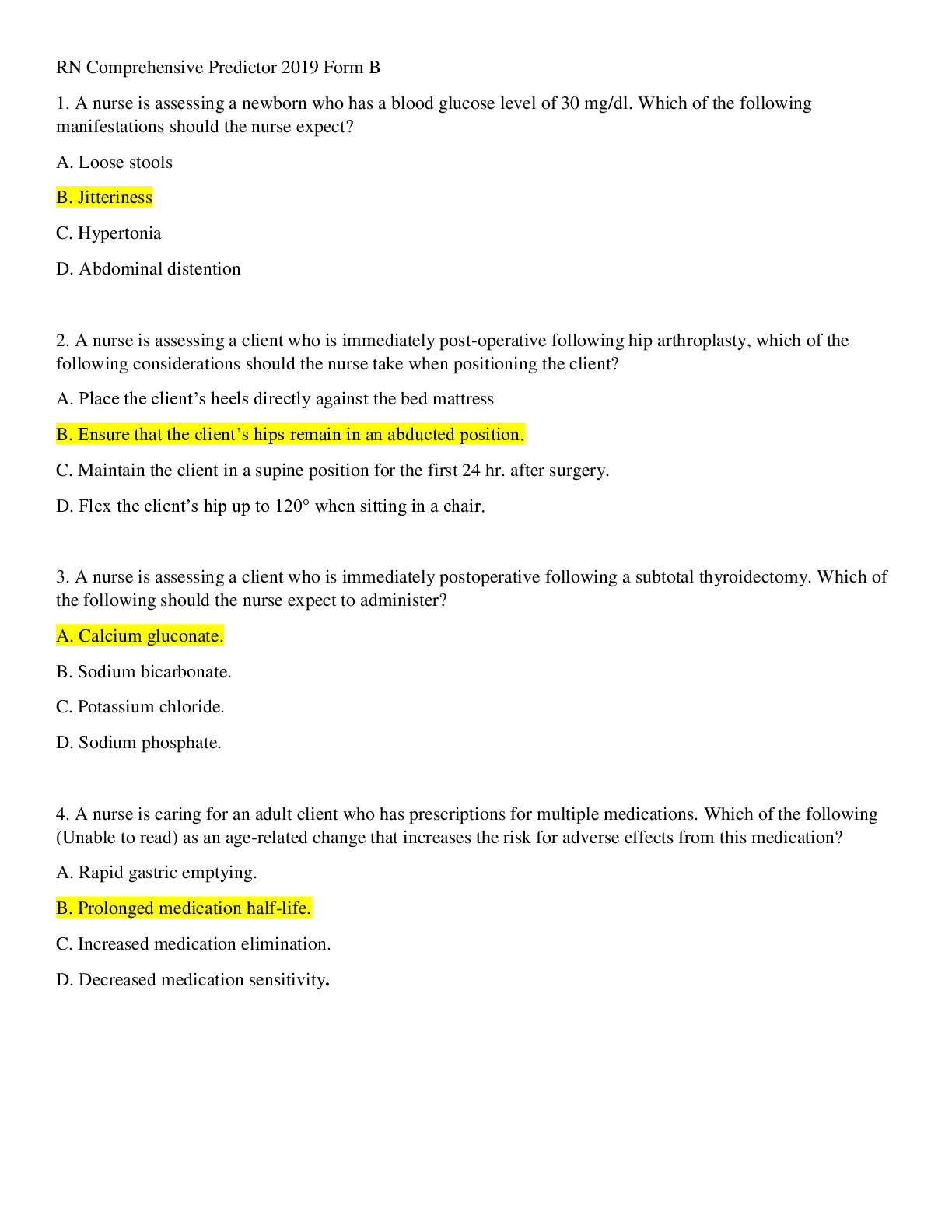



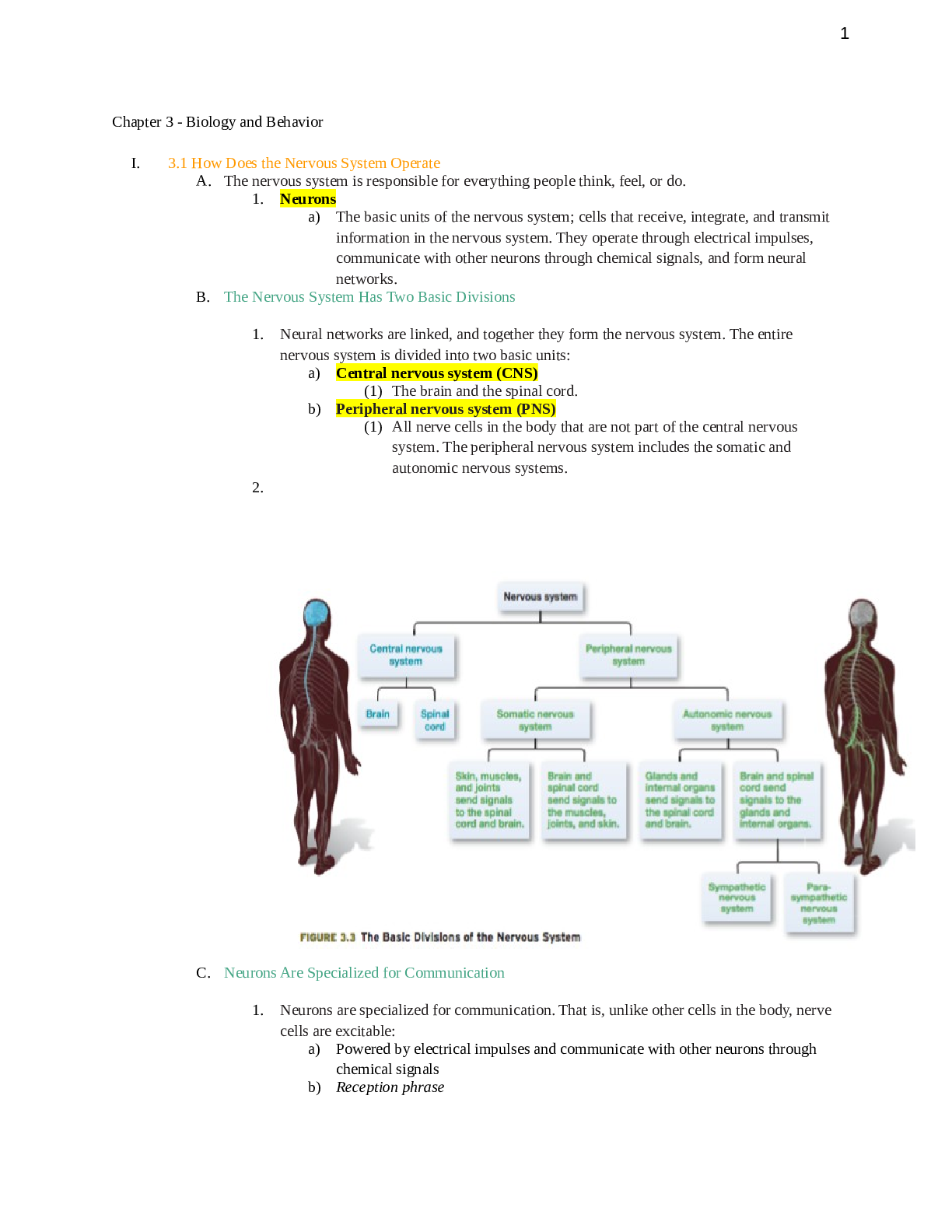



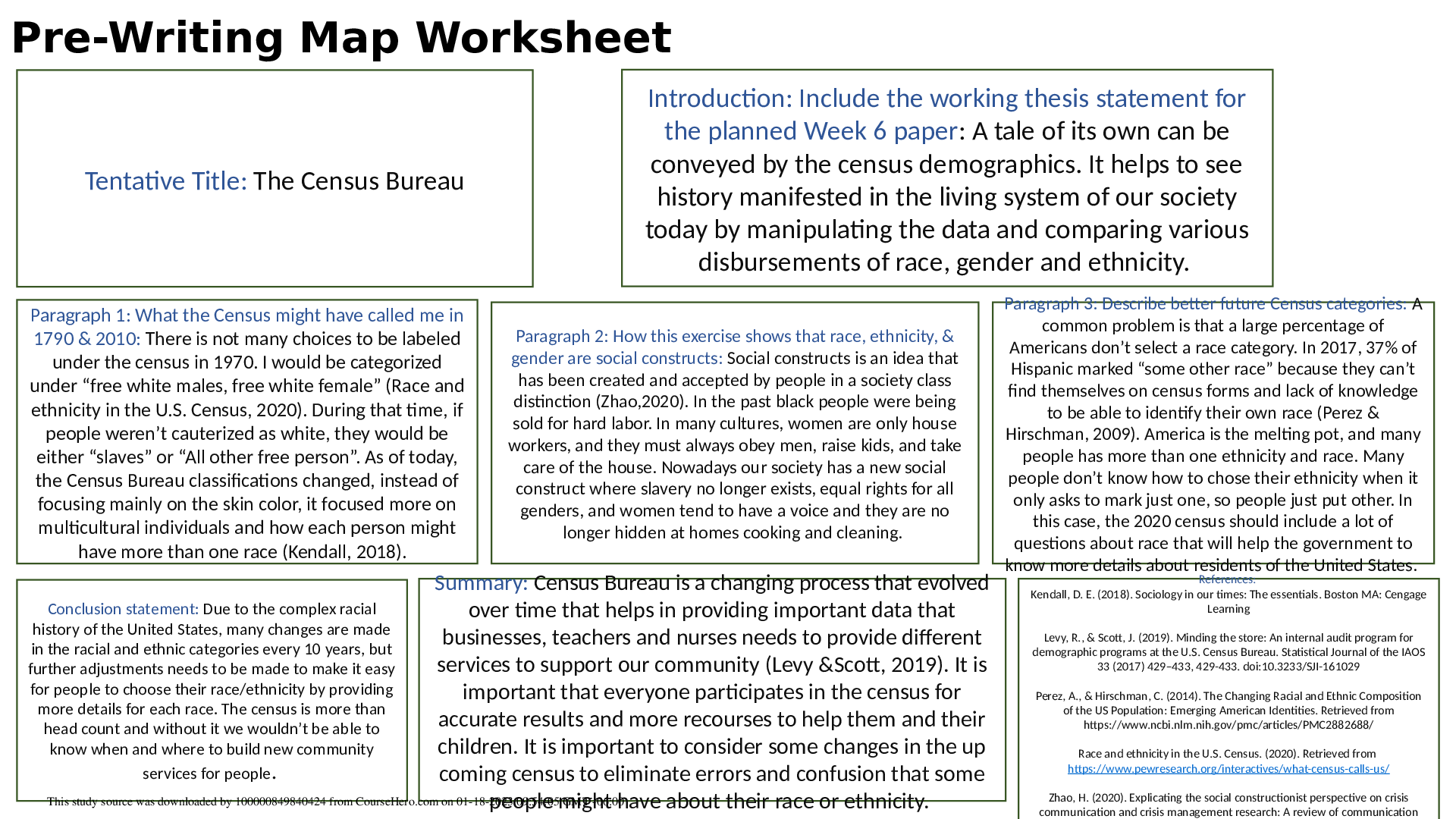
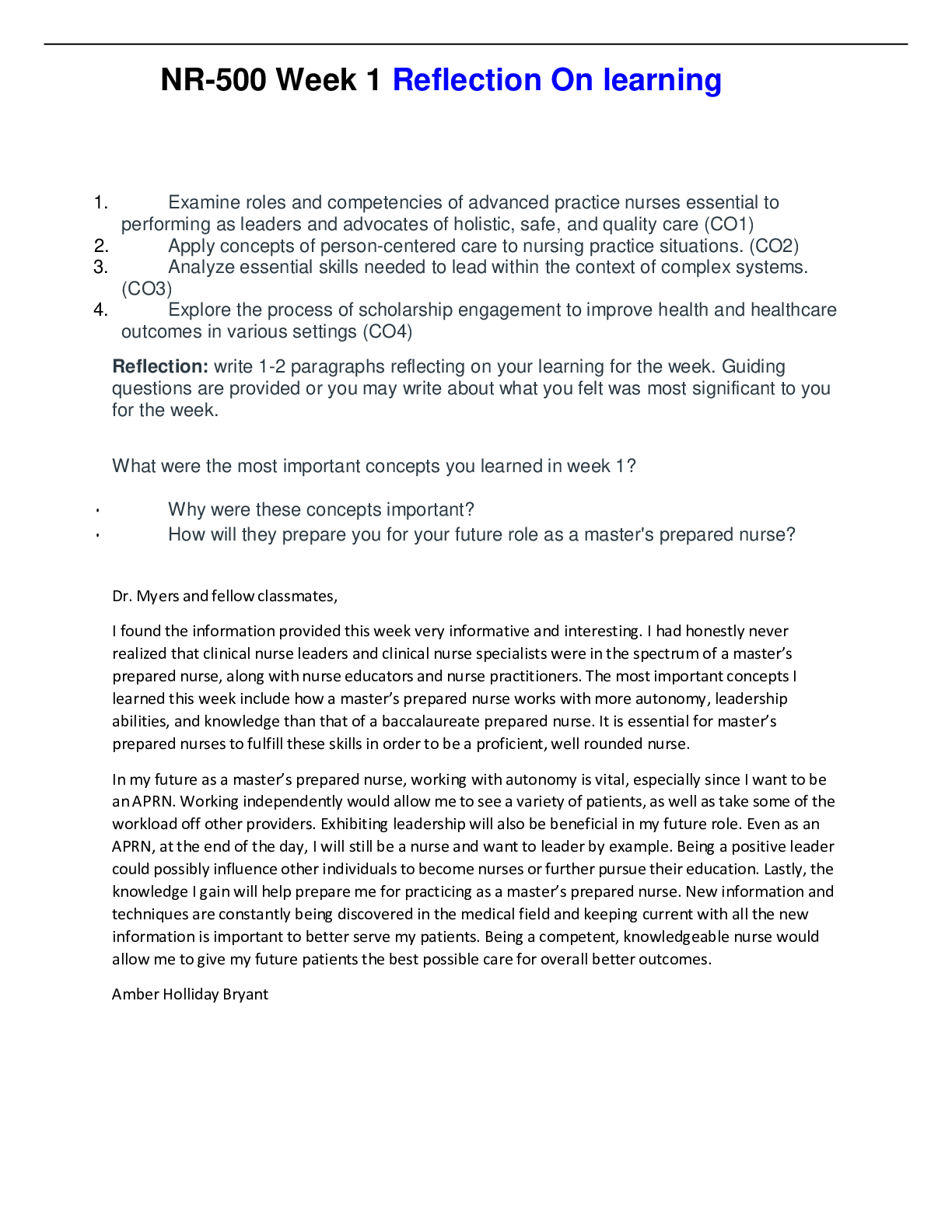


 (1).png)
 (1).png)


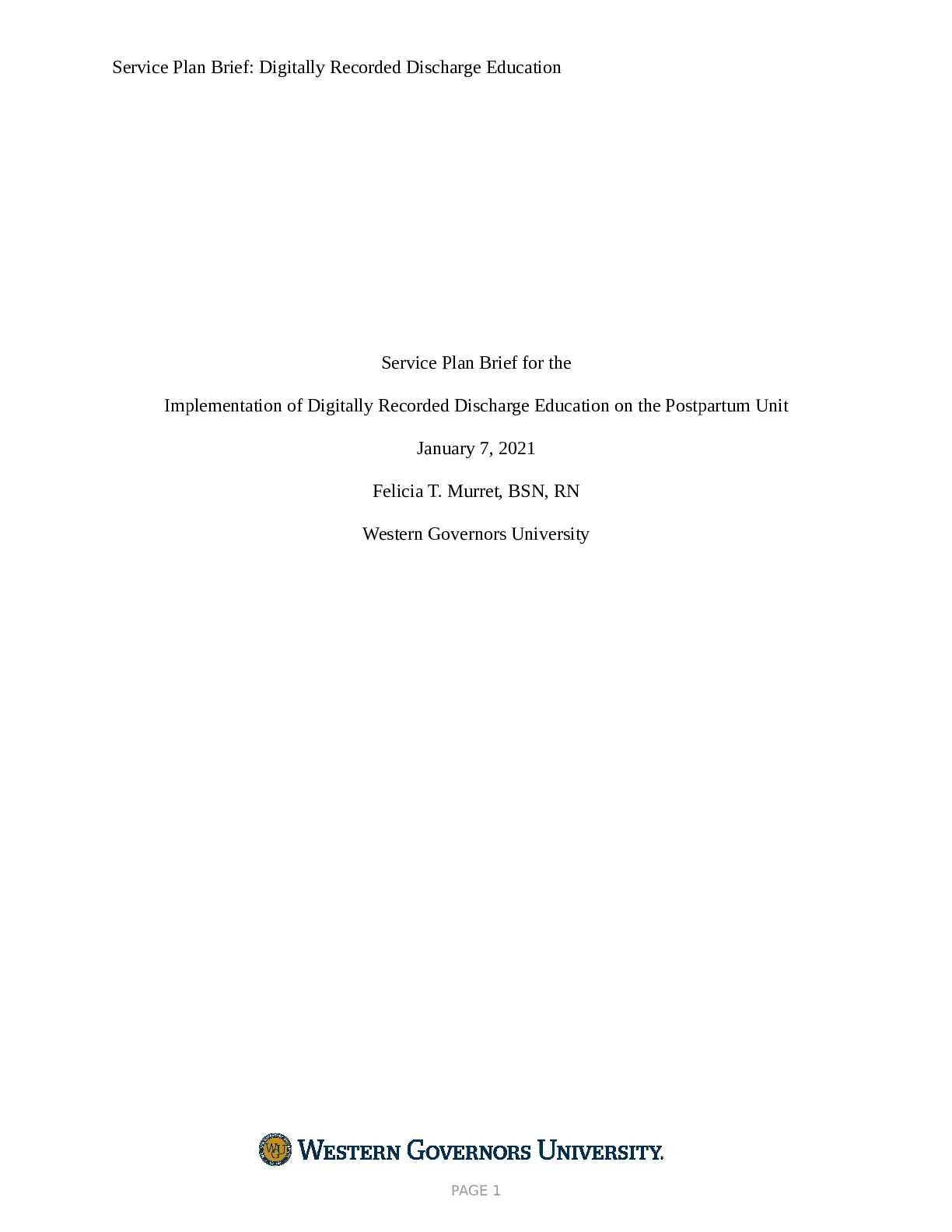
.png)









